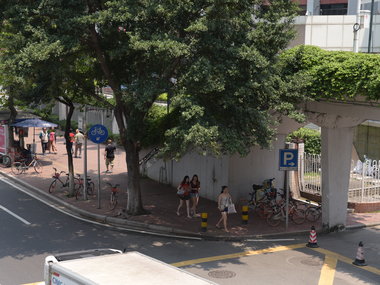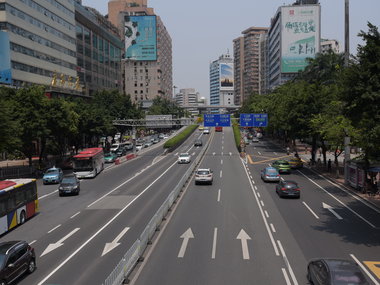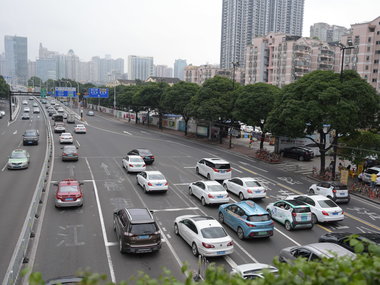
A history of bicycle mobility in urban China: infrastructure, economy, and urban planning (Part 1 of 2)
Jun Zhang
Zhang, Jun. 2022. A history of bicycle mobility in urban China: Infrastructure, economy, and urban planning (Part 1 of 2). MoLab Inventory of Mobilities and Socioeconomic Changes. Department ‘Anthropology of Economic Experimentation’. Halle/Saale: Max Planck Institute for Social Anthropology. https://doi.org/10.48509/MoLab.9267
Download as PDF
As concerns about fossil fuel use and carbon emissions soar, a number of countries, such as the Netherlands, have included the promotion of cycling as part of their commitment to addressing climate change. Similarly, major cities like London and New York have included investment in cycling infrastructure in their urban redevelopment initiatives. Yet the question remains, can we bring back, or bring in, bicycles as one of the main vehicles of daily transportation and thereby help slow down climate change?
In this entry and the next, I argue that turning the low-emission potential of bicycles into a major, long-term form of daily transportation requires crucial networks of infrastructures. These infrastructures not only include technical and physical infrastructures like bicycles and cycle lanes, but also non-material infrastructures like government regulations and urban design, all of which are shaped by various social, economic, and political forces. The specific configurations of bicycle mobility may vary from one place to another, as the sociotechnical systems that simultaneously support and constrain such mobility differ in space and time. This entry, as well as the next (https://www.eth.mpg.de/molab-inventory/mobility-infrastructure/history-of-bicycle-mobility-in-urban-China-part-two), traces bicycle mobility in China from the 1970s to today. In doing so, they illustrate how the sociotechnical infrastructures of bicycle mobility have been shaped and transformed in a specific historical process, and how a critical reflection on existing ways of understanding and imagining progress, equality, and urban development is essential in making bicycle mobility a viable, sustainable form of transportation.
This entry focuses on how bicycle mobility and infrastructures are shaped by, and are shaping, visions and practices in politico-economic models, development, and urban forms. Before the rise of automobility in the 21st century, China was known as a kingdom of bicycles. This bicycle-centric mobility, which grew throughout the 1970s and 1980s and peaked in the early 1990s, was embedded within “work unit urbanism”, a key aspect of the centrally planned economy. As the paradigm of development has gradually changed since the mid-1990s, the process of urbanization has become increasingly growth-oriented and accompanied by a politics of the spectacle. The replacement of bicycle-centric mobility with other forms of mobilities is not merely the result of growing consumer power (rising private car ownership) or a story of infrastructural accomplishment (the development of public transportation). Drawing on my early life in Guangzhou and more than a decade of ethnographic fieldwork on physical and social mobility in urban areas of the Pearl River Delta area in southern China, I show how bicycles have been transformed from daily necessities to markers of status, the meanings and practices of which have been reconfigured in an increasingly stratified society.
Bicycle-centric mobility in China: The 1970s to the mid-1990s
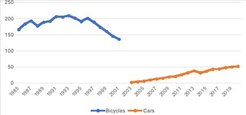
Bicycles were essential household items in Chinese cities from the 1970s to the mid-1990s. The number of bicycles per household peaked in the mid to late 1990s in different cities. And although economic reforms began slowly in the late 1970s, one would still require a ration to buy a bicycle for another decade.[1]
In the boom years, there were three major brands of bicycle: Phoenix (fenghuang), Flying Pigeon (feige), and Five Rams (wuyang).[2] The cycles were simple and robust, with classically styled frames for men and women. There were three standard sizes: 24, 26, and 28 cun (inches; diameter of the wheel). The cycles had a number of minor problems: the handlebars did not align well with the frame, the chain frequently came off, the brakes were either too tight or too loose. But most could be easily fixed. Just as many East German motorists knew how to fix their own Trabants, Chinese cyclists developed the skills to fix basic problems with their cycles. And one could easily find small or one-man workshops to inflate tires and complete repairs for a nominal fee.
The centrality of bicycles in everyday mobility was part of the “work unit urbanism” which characterised the Maoist era and the early reform years. In this period, the top priority was not growth per se. Urban development was subjected to the visions and constraints of the centrally planned economy, which placed strict controls on the urban population. Work units (danwei)—government agencies, state-owned enterprises and institutes—were not merely places of work but also “the spatial hubs through which social provisions were distributed and around which social lives were organised in cities”.[3] Many work units provided housing for their employees and their families. Facilities central to daily life—such as clinics, day care centres, or schools—were often affiliated with work units or neighbourhoods and were near home or work. Work units were also a key node of social networks, meaning residents often did not need to travel far to socialise.
Public transportion was not well developed and the few automobiles on the streets were mainly buses and trucks. Unlike in East Germany or the Soviet Union, private car ownership was associated with a bourgeois lifestyle and was discouraged. Industrial capacity for automobile production was extremely low. Although joint ventures for car production were set up in the mid-1980s, key parts still had to be imported, and the annual production of passenger cars remained low.[4] For many residents, cycling was not an alternative to taking the bus or driving a car, it was the means of transportation.
Bike lanes were common in the cities. Then China correspondent for The New Yorker Evans Osnos wrote a jolly taxonomy of the cycle lanes in Beijing, a taxonomy that included three species based on how exclusive the space was reserved for bicycles.[5] While Osnos’s mapping of the cycling space reflects the invasion of cars in the twenty-first century, his taxonomy still bears an imprint from the previous era. Along the major arteries, cycle lanes were often wide enough for auto traffic. They ran parallel to—but were separated by trees from—the roads, which were mostly two-to-four lanes wide (figure 1). In the narrower streets, there may not have been a physical marker separating the cycle from the auto lanes, but there was an informal understanding that cyclists took the right and drivers the centre of the road. While conflicts between cyclists and drivers did exist, there was little competition between the two. Given the number of cycles on the streets, especially during rush hour, cycle traffic jams were not uncommon.
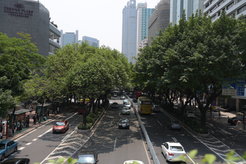
Growing up in Guangzhou, I started to cycle to school with my father at my side when I was 10. While I did start a little early, it was normal for teenagers to cycle without their parents to school or to socialise—at friends’ home or in parks—in the 1980s and 1990s. The one or two students who could not ride a bike would often be made fun of by the rest of the class. And the fact that parents were unconcerned about their teenage children cycling around the cities suggest it was generally considered safe.
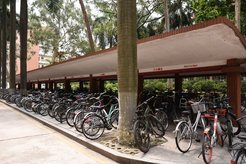
In the cities, one typically found bicycle parking lots in schools, workplaces, and residential areas. The lots were typically simple structures—a roof to shield the cycles from rain and bars to lock them to (figure 2). In pedestrian areas, cycles could often be parked in guarded areas for a nominal fee. When family members or friends went out, it was also common to chain bicycles together to prevent theft.
The marginalisation of bicycle-centric infrastructures: The mid-1990s to today
The 1990s witnessed a paradigmatic shift in the master plan for national development. Economic growth became the priority—and urbanization was identified as a key means of achieving that growth. Since that time, cities have expanded exponentially by incorporating surrounding villages, towns, and sometimes even other cities. While the system of household registration has continuously reproduced territorially bounded privileges and status, the urban population had increased from less than 20 percent in the late 1970s to more than 60 percent by 2020.[6]
The new mode of urban development, which can be characterised as land-centred, real-estate driven and infrastructure-led, has led to the substantial reshaping of urban landscapes. Unlike work unit urbanism in which urban spaces were functionally mixed, contemporary planning practice favours functional divides and zoning. In today’s cities, areas like the “Financial District”, “Central Business District,” “Science City” and “Industrial Parks” are common place. Juxtaposed with, and often located far away from, these work zones are the new residential areas—including urban villages, gated complexes, and subsidised housing. It is not uncommon for gated complexes, tailored for middle-class families, to have more than 10,000 residents and include swimming pools, club houses, basketball courts, gyms and in some cases, primary and/or middle schools (as required by local government). Some of the larger complexes even offer golf carts for residents to move around in.
As a result of these planning and development practices, the nodes of daily life have becoming increasingly spread out. In my years of observations, it remains unclear whether urban residents do more outside the home than they did before, but it is clear that the territorial coverage of their daily movements has grown significantly, travelling to different districts for work, education, leisure, medical care, and back home again. This spatial transformation has brought with it a major infrastructural challenge: the need to move urban residents around effectively and efficiently in ever-expanding cities.
Forced to travel increasing distances in daily life, the rising middle class has turned to private automobile ownership. This has been made significantly more affordable by the growing auto industry, which has received strong government support since China joined the World Trade Organization in 2001.[7] Meanwhile, local governments have invested heavily in intra- and inter-city public transit systems such as subways and buses. Moreover, the demand for transportation in cities coincides with a national development strategy where the construction of infrastructure such as high-speed railways and highways has been used to stimulate economic growth, particularly since the global financial crisis in 2008.
This functionally-divided, infrastructure-led mode of urban development has come with a politics of the spectacle.[8] Neatly organised urban space and mega-structures with spectacular visual effects are seen as symbols of modernity by everyone from government officials to planning professionals and ordinary citizens. Old neighbourhoods have not been bulldozed simply to yield prime locations for real estate development, but also because their winding streets and low-rise buildings are often considered “outdated” and out-of-place in the “modern” cityscape. In the modern city, roads are to be monofunctional, and vendors—including those that fix bicycles—have been pushed off the streets and the footpaths.[9] Aerial photographs reveal the awe-inspiring spectacle of the “modern” Chinese city: a grid of major blocks and shining high-rises, boulevards more than ten lanes wide, and huge, complex roundabouts. However, the visually appealing urban built environments are often pedestrian unfriendly.
While planning in the era of work unit urbanism favoured bicycles, today it favours streets designed for automobiles, with boulevards, inner-city expressways, underground tunnels, and overhead footbridges. New roads are constantly being built and old ones expanded to accommodate the ever-growing number of cars. At the same time, the width and length of these roads, as well as the overhead walkways needed to transverse them, make them especially unaccommodating to pedestrians and cyclists. While there has been some effort to (re)designate space for bicycles in recent years, cycle lanes often go through pedestrian zones, or are nothing more than a metre-wide lane along the sides of busy boulevards. These cycle lanes are often poorly connected, disappearing from one section of the street to the next. And with cars parking along the curb, cyclists often find themselves forced into the middle of traffic (figures 3, 4, 5). Little surprise then, that today few urban residents appear to consider city cycling safe.
As the bicycle lanes have disappeared from the streets, so have another indispensable part of the cycling infrastructure—the parking lots. These are essential because although bicycles take up less significantly space than cars, the numbers still do add up. Today many of these spaces have been cleared out, demolished, or transformed into green spaces or car parks. And the small repair workshops and the one-man businesses once found on the main streets—they too have gone.
Conclusion: Changing cycling practices and bicycle mobility
Bicycles are no longer household necessities for most people in China. Yet as the market provides diverse consumption options, bicycles and cycling have taken on new meanings as markers of status. While one can still see the older-style of bicycles in streets, cycles with more elaborate designs and/or from reputable brands are available to middle-class users with considerable purchasing power.[10] If cycle accessories once meant a basket on the handlebars or a child seat, today they might include a wide range of items—from a pump to a water bottle and mobile-phone holder, a helmet, gloves, knee pads, and specialised clothing. For the middle class, cycling has become a popular leisure activity: families cycle together through parks or along scenic trails on the weekend; professionals sweat through spinning classes in gyms; companies do team-building cycle tours through the mountains, the countryside, or somewhere else far away from urban traffic; and cycling features in fundraisers for environmental protection.
Few urban residents commute by bicycle in their daily lives today, relying instead on public transport or their own car. In the debate around transportation among policy makers and experts, a commonly proposed solution to the problems caused by car cultures—pollution, traffic congestion, health issues and so on—is cycling. However, this typically individualised solution overlooks how a specific form of physical mobility is always enmeshed within a web of infrastructures shaped by specific social forces. As the changing dynamics and manifestation of bicycle mobility enabled by shared bikes in China suggests (A history of bicycle mobility in urban China: shared bikes, technology, and environment), simply bringing bicycles back into the city is not enough to develop long-term, sustainable alternatives to current modes of mobility.
[1] Notar, Beth. 2015. From Flying Pigeons to Fords: China's New Car Culture. In: A. Prescott (ed.). East Asia in the World: An Introduction. New York, NY: Routledge, pp. 122-139; For detailed descriptions of consumption during the Maoist era. see Gerth, Karl. 2020. Unending Capitalism: How Consumerism Negated China’s Communist Revolution. Cambridge: Cambridge University Press
[2] Rhoads, E. J. M. 2012. Cycles of Cathay: A History of the Bicycle in China. Transfer 2 (2): 95–120.
[3] Santos, Gonçalo and Jun Zhang. 2021. Urbanization in China. In: The International Encyclopedia of Anthropology. John Wiley & sons, pp. 1-6; see also Lu, Duanfang. 2006. Remaking Chinese Urban Form: Modernity, Scarcity, and Space, 1949-2005. London. New York: Routledge.
[4] See “Prologue” in Zhang, Jun. 2019. Driving toward Modernity: Cars and the Lives of the Middle Class in Contemporary China. Ithaca: Cornell University Press.
[5] Osnos, Evans. 2011. The Bike Lanes of Beijing. The New Yorker. Available online at: https://www.newyorker.com/news/evan-osnos/the-bike-lanes-of-beijing. Last accessed 7 February 2022.
[6] National Bureau of Statistics of China. 2020. Individuals with a rural status in the household registration system nowadays can move to the cities, however, they typically have no access to most of the social benefits available to individuals with an urban status.
[7] For more ethnographic description and discussion see Zhang, Jun. 2019. Driving toward Modernity: Cars and the Lives of the Middle Class in Contemporary China. Ithaca: Cornell University Press.
[8] I explore the design aesthetics of transport infrastructure and officials’ performance records in Zhang, Jun. 2016. Taxis, Traffic, and Thoroughfares: The Politics of Transportation Infrastructure in China's Rapid Urbanization in the Reform Era. City & Society 28 (3): 411-436.
[9] Hanser, Amy. 2016. Street Politics: Street Vendors and Urban Governance in China. The China Quarterly 226: 363-382.
[10] See also Christensen, Hilda R. 2017. Is the Kingdom of Bicycles Rising Again? Cycling, Gender, and Class in Postsocialist China. Transfers 7 (2): 1-20.
This is an Open Access article, distributed under the terms of the Creative Commons Attribution licence (https://creativecommons.org/licenses/by/4.0/), which permits unrestricted re-use, distribution, and reproduction in any medium, provided the original work is properly cited.



